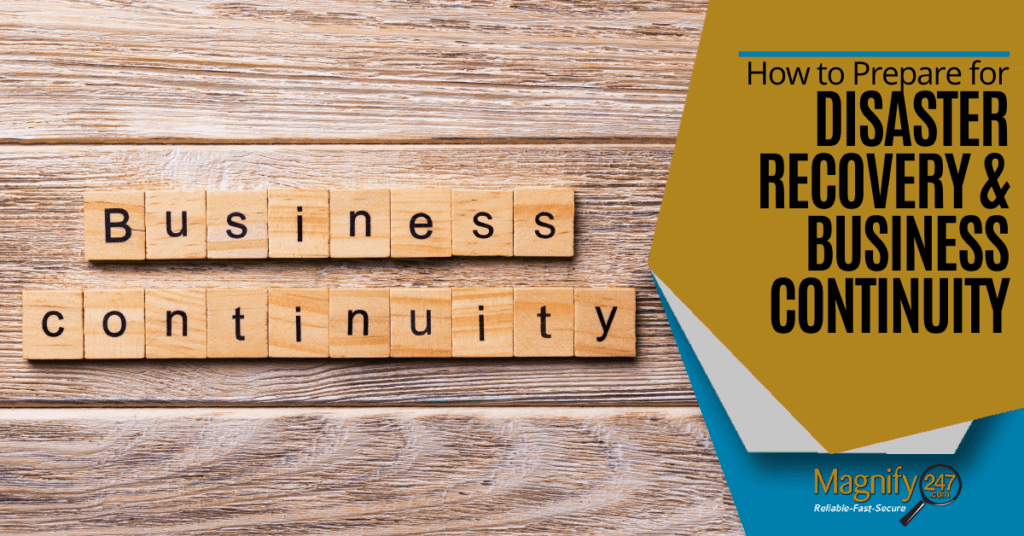There are business-disrupting events lurking around every corner, both big and small. Companies can suffer from extended power outages due to storms, and disruptions that last several days, such as a major snowstorm or hurricane. There are also transformative disruptions that can impact business for more than a year, like a global pandemic.
watch short video > https://youtu.be/49qE240nuSs
In all these cases, if companies want to remain resilient and in business, they need to be prepared to deploy a “Plan B.”
Creating that Plan B is what disaster recovery and business continuity are all about.
What are the costs if you don’t properly address business continuity?
Your business could end up never recovering from a disaster. 40% of small businesses never reopen their doors after a disaster strikes, and an additional 25% end up failing within a year of a crisis event.
Following, are some of the most important things to consider when putting together a business continuity plan or evaluating your current plan to ensure it’s providing you with sufficient protection.
Where Are You Going to Work?
While not all disasters will entirely destroy your office, warehouse, or factory, as we saw during COVID-19, you may have to vacate your primary business location for other reasons.
Disasters can cause both a short-term and long-term need to move your entire operations elsewhere.
Where are you going to work if you can’t work in your normal place of business?
For many companies, operations were moved to remote employee homes as everyone hunkered down during the pandemic. Prior to the pandemic, approximately 24% of US workers worked from home 5+ days per week. After the pandemic began, that number jumped to 53%.
But what happens if you have a factory or a doctor’s office and have a flood, fire, or some other damage to your building? You can’t exactly run your operations from employee homes.
In this case, you would want your business continuity planning to include other facilities that you have lined up in case you need to move operations swiftly.
For example, if you’re a manufacturer, you may work out an arrangement with a competitor that would give you both an alternate place to operate temporarily if either one suffered a disaster.
If you have a retail location, then you’ll want to identify potential alternate facilities that you could use in the event of a disaster to your current location. While another location might not be ideal, it could keep you in business while you were recovering from the event.
Having a plan in advance for where you could alternately run your operations, helps you mitigate downtime during a crisis event and gets you back on your feet much faster.
What Technology Solutions Do You Need?
When you can’t operate from your normal place of business, having the right technology tools becomes vital to keeping your team connected to their work, to each other, and to your customers.
How are you going to answer your phones if your on-premises phone system is fried by a lightning strike of the lines? What happens to all your data that was backed up to an on-site server if a tornado comes through?
It’s important to identify and put the tools you need in place BEFORE a disaster strikes. Cloud technology has been a “must-have” infrastructure during the pandemic, but this is also true during any type of disaster that causes you to have to temporarily run your business from somewhere else.
Some of the technology solutions to consider putting in place:
- Cloud infrastructure (cloud accessibility for any productivity tools your company uses)
- Offsite cloud data backup and recovery
- Remote managed IT services
- Unified cloud communication system (e.g., Microsoft Teams)
- VoIP phone system
- Cloud-based accounting system (e.g. QuickBooks Online)
- Hardware that employees can use at home (e.g. Laptops, headsets)
Does Your Team Know What to Do?
Once you have your “Plan B” in place with an alternate location and cloud technology tools, you need to ask yourself, “Does my staff know what to do if a crisis event happens?”
It’s important to document your business continuity and disaster recovery plan as clearly as possible. This includes having step-by-step instructions for staff to follow in case of any number of different crisis events, such as a ransomware attack, extended power outage, major disaster, pandemic, etc.
Being familiar with a plan and having those steps to follow will aid your recovery efforts and get you back to business quicker.
Get Help With Disaster Recovery & Business Continuity Tools
Magnify247 can help your Hamilton County business with the technology solutions you need to ensure you’re ready for anything.







